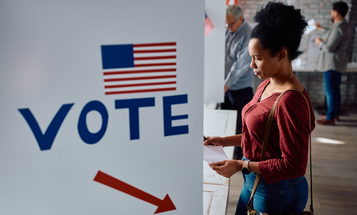
How the Wisconsin Voter Purge Targets Black Voters
A conservative group is suing to force the state of Wisconsin to purge 234,000 from voter rolls. According to our analysis of Census data, this could disproportionately target voters of color.

In 2016, Donald Trump won the state of Wisconsin by fewer than 23,000 votes out of almost 3 million cast in the state. Now, as we enter 2020, a massive voter purge threatens to skew the electorate and prevent eligible voters from having their say.
In October, the conservative Wisconsin Institute for Law and Liberty (WILL), a group that has backed former governor Scott Walker’s attacks on organized labor, filed a lawsuit against the Wisconsin Election Commission, asking the court to force the Commission to purge 234,000 voters from the state’s voter rolls. One week ago, a judge ruled in WILL’s favor and ordered the purge. According to our analysis, the voters targeted for removal are disproportionately voters of color.
Why Are Voters Being Purged in Wisconsin?
WILL’s lawsuit targets voters who were flagged as having moved through an interstate system known as ERIC. [...] But ERIC doesn’t always get it right.
WILL’s lawsuit targets voters who were flagged as having moved through an interstate system known as the Electronic Registration Information Center (ERIC). ERIC pools voter registration, postal service, and driver’s license information from member states and attempts to identify voters who have moved within the state or to another member state, allowing states to remove those who have become ineligible to vote in the election district in which they are registered. But ERIC doesn’t always get it right. In 2017, the first year Wisconsin participated in ERIC, 46,000 of the more than 340,000 individuals on Wisconsin’s ERIC list—double Trump’s margin of victory—were incorrectly flagged as having moved. These individuals were purged after failing to respond to a mailed notice that gave them 30 days to confirm or update their registrations.
Recognizing the inaccuracies in the ERIC list and having experienced the consequences in the 2018 election cycle when the names of thousands of eligible, registered voters were missing from poll books when they went to vote, the Wisconsin Election Commission decided to take it more slowly the second time around. Voters on the 2019 ERIC list would be given until after the 2020 election to confirm or correct their registrations—which they could do by responding to a mailing or by confirming their address at the polls on election day. Protecting voters from improper removal would mean higher participation by eligible voters. WILL sued to prevent WEC from taking that voter-protective approach. The lawsuit charged that Wisconsin law requires voters on the ERIC list to be purged if they don’t respond to the mailing within 30 days. Last Friday, Ozaukee County Circuit Judge Paul Malloy agreed and ordered the Election Commission to begin cancelling registrations immediately.
Who Does the Purge Target?
We can use demographic data from the U.S. Census Bureau to estimate the impact this purge could have based on race in Wisconsin.
The Wisconsin Election Commission has not publicly released the list that was used to target voters for removal, and this lack of detailed public data prevents us from knowing exactly which voters are affected by the court’s order. But we can use demographic data from the U.S. Census Bureau to estimate the impact this purge could have based on race in Wisconsin. These data indicate that a disproportionate number of mailers were sent to areas with large Black voting bases.
While the Black voting population comprises only 5.7% of Wisconsin’s total electorate, the highest concentrations of 2019 ERIC mailers were sent to areas that are home to the largest Black voting population in Wisconsin. Over one-third—35%—of the mailers sent to voters on the 2019 ERIC list went to the two counties where the vast majority of Wisconsin’s Black voters reside, Milwaukee and Dane. These two counties are home to three quarters—74.665%—of Wisconsin’s Black voters; Black voters make up 17.45% of these counties’ entire electorate.1
And while these counties are large, they are not large enough to account for the significantly higher number of their voters targeted in WILL’s lawsuit. For example, Milwaukee County makes up 15% of Wisconsin’s electorate, but received almost 22% of the mailers. Similarly, Dane County makes up 9% of the electorate and received 13% of the total mailers. In comparison, Fond Du Lac County, which has an electorate that is 96% white, makes up 2% of Wisconsin’s total electorate and received 1.4% of mailers.
Census data also indicate that this voter purge could negatively impact Latino and Asian American voters in Wisconsin. Milwaukee County is home to 37.32% of the state’s Latino voters, and 20.73% of its Asian voters.2 Many of these voters have a limited ability to understand English, but the ERIC mailers were not provided in any other language.
Disenfranchising Voters of Color Harms Democracy
The court-ordered voter purge in Wisconsin will fall disproportionately on some of the most vulnerable voters. Although Wisconsin allows registration right up through Election Day, voters who want to register at the polls have to bring proof of address—something voters who believe they are registered don’t think to take with them when they go to vote. And when more voters have to register on Election Day, it increases the amount of time everyone has to wait in line to vote.
Disproportionately excluding voters of color will weaken democracy in the state and could have profound effects for the nation.
Disproportionately excluding voters of color will weaken democracy in the state and could have profound effects for the nation. Voting rights advocates in the state have now asked a federal court to intervene and stop this unwarranted and discriminatory purge. Whatever the courts may do, Wisconsin voters must recognize the purge for what it is: undue voter suppression that will hit communities of color hardest.
- 12018 ACS 1-year estimates available at https://data.census.gov/cedsci/table?q=&g=0400000US55.050000&hidePreview=true&table=S2901&tid=ACSST1Y2018.S2901&lastDisplayedRow=34
- 22018 ACS 1-year estimates available at https://data.census.gov/cedsci/table?q=&g=0400000US55.050000&hidePreview=true&table=S2901&tid=ACSST1Y2018.S2901&lastDisplayedRow=34




